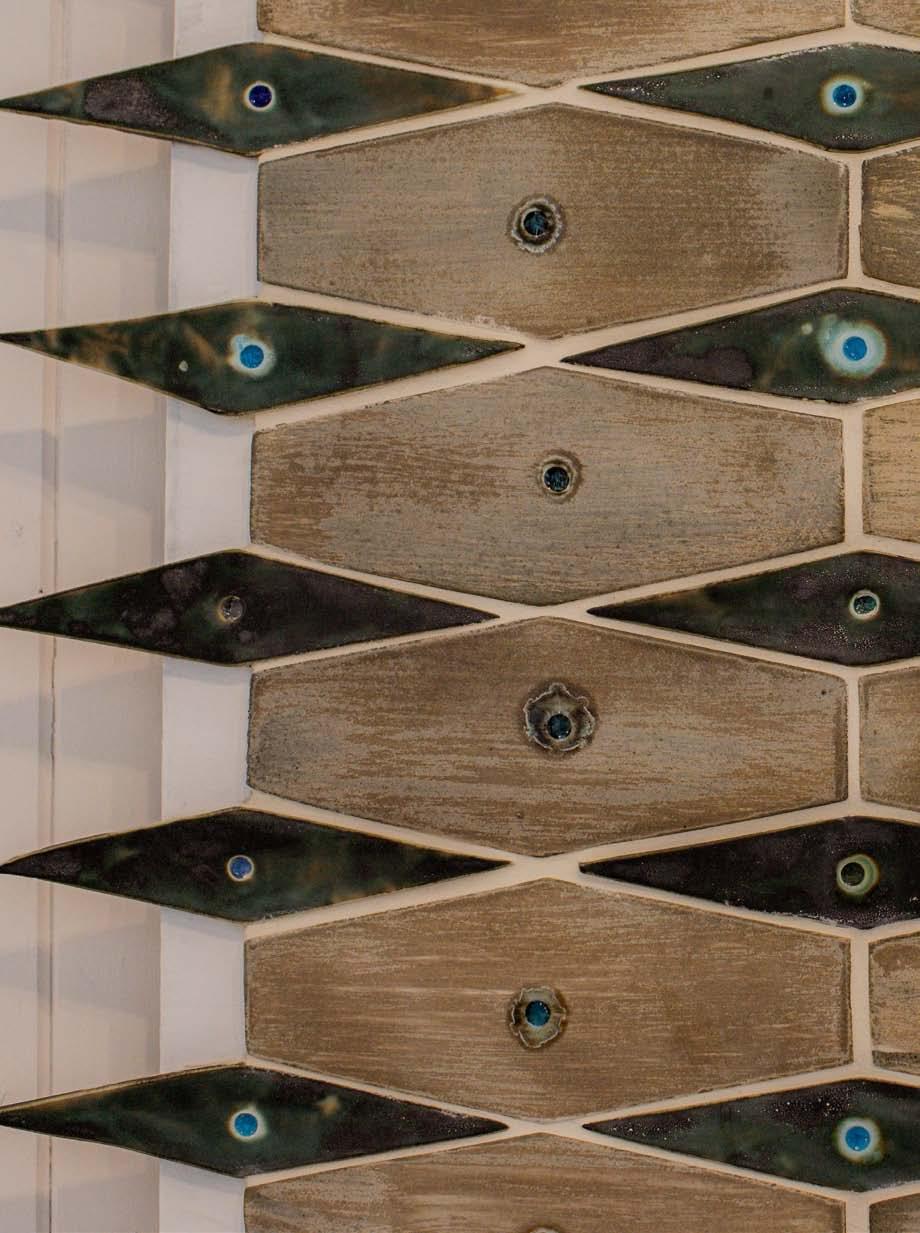
7 minute read
A lasting impression
from aboutfram issue 25
by aboutmedia
about design
about design
Advertisement

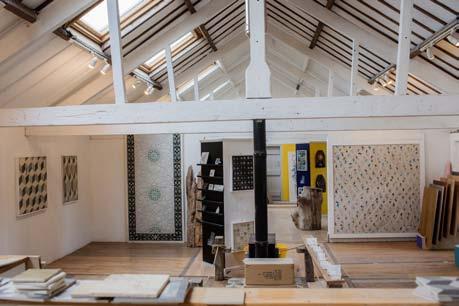

Smoke & Fire has been perfecting the process of crafting handmade tiles for over twenty years. We met up with the founder Mark Aldridge and his son Boris at their workshop in Darsham to learn more about the intricacies of the family business.
Based on the A12 just opposite Darsham Railway Station, the workshop/salesroom at Smoke & Fire was originally an old granary and the blackened exterior gives few clues as to the treasures that lie within. Mark set up the company in 2000 after moving to Suffolk from Lincolnshire, and he now runs the business alongside his son Boris, an established contemporary ceramist, artist and musician. Having previously studied Fine Art, setting up his own handmade tile company was a new commercial venture for Mark, but he was drawn to the idea of being able to create unique tiles, decorated with his own, hand drawn paintings and designs, and to experiment with size, patterns, colour and glaze.
The showroom upstairs is a large light-filled space that has been used to great effect to allow Mark and Boris to show off the full extent of their bespoke range. Sections of the room are decorated with different examples of the artisan tiles: some glazed; others textured and embedded with glass or inlaid with gold leaf. Geometric patterns square up to delicately painted birds, huge mosaic panels with detailed Islamic designs counter the simplicity of a single cream tile
about design
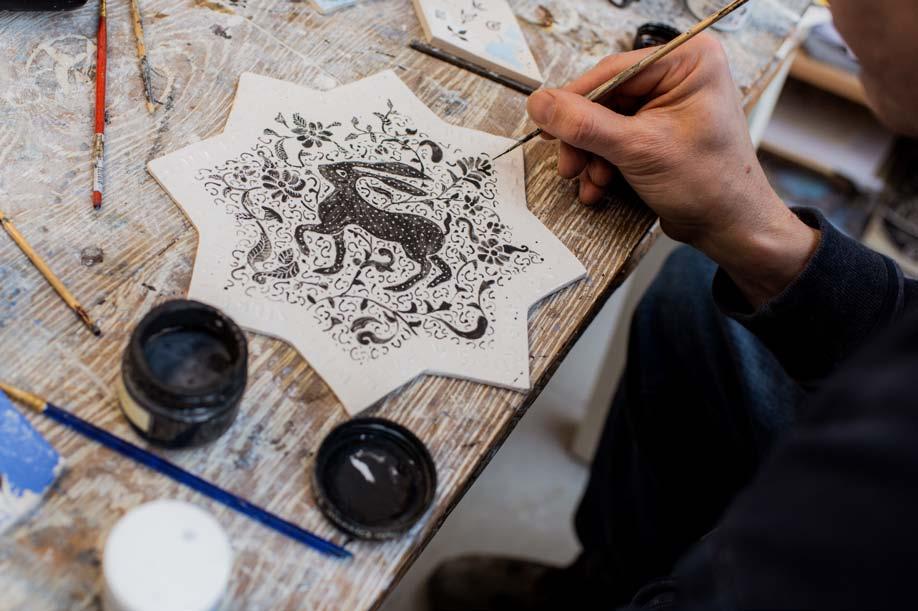
imprinted with just a pair of glazed dots, and in a corner a shoal of little black fish dance amongst their ceramic waves. The work is beautiful and highly skilled, and I love the individuality of the designs, especially those using mixed media where the glass from old wine bottles creates a myriad of reflective colour.
Down in the workshop, Mark explains the process they use for the majority of their tiles. The clay comes from Stoke-on-Trent, famous for its pottery and the quality of the local clay, and this raw material is initially put through a pug mill which squeezes out any air bubbles and rolls the clay into blocks. These are then cut to the required shape and size and the tiles are left to dry naturally on wooden boards. At this stage they can also be imprinted with any specific designs and it is fun to see that Mark and his team have used some ingenious objects to leave their impressions. Who knew that when pressed into clay an old-fashioned meat mallet could create such wonderful speckling, or the end of a hosepipe such fabulous concentric circles, and that the pattern left behind by a simple button could look so effortlessly contemporary?
Next comes the messy part – glazing the tiles. The glaze is mixed by hand according to secret family recipes using ingredients such as china clay, zinc oxide, rutile, cobalt and feldspar, each one having a differing quality that effects the tone, opacity and warmth of the final colour. The glaze is sprayed onto the tiles by hand in a specialised spraying booth and they are then fired in a gas kiln at temperatures of up to 1240°C. Once they have cooled, the
about design
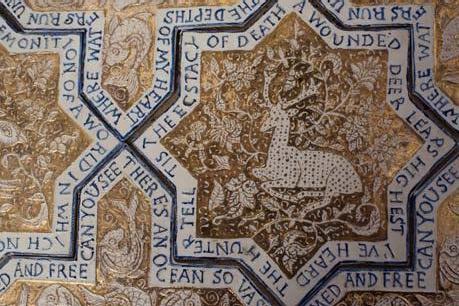
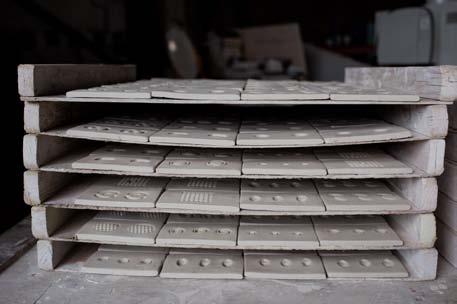
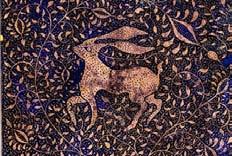
delicate hand painted detail is added and a second glaze applied before they are put back in the kiln for a second time. This process, known as biscuit firing, gives them a rich patina and each one will have tonal variations and undulations that can only be found in a true artisan handmade tile.
Boris has perfected this technique and specialises in creating exquisitely decorated tiles inspired by the Persian lusterware of the 13th century. They are incredibly detailed and often painted with liquid gold, giving the surface with an extraordinary lustre, or inscribed with lyrics from folk songs he himself has written, which instil within them a wonderful sense of spirituality. Boris has had solo exhibitions in Suffolk and London, and his intricate hand carved designs are now highly collectable. His work is currently represented by the prestigious Amir Mohtashemi gallery on Kensington Church Street, and a collection of his songs, whose lyrics are rooted in the coastal landscape of Suffolk, are for sale via the Alde Valley Spring Festival.
Running a family business can be tricky, but after visiting Smoke & Fire it is so rewarding to see one that continues to evolve and change with the times. Mark and Boris clearly have huge respect for each other’s work, the delicately hand painted wading birds perfectly in harmony with the elaborate shimmering lusterware, and both have certainly made a lasting impression on me.
www.smokeandfire.co.uk
about gardens

Contain yourself!
about gardens

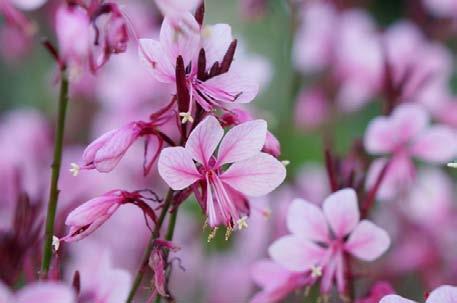

I am still learning the art of having a garden that flowers effortlessly all year round. Once the night-scented stocks, aquilegia, marguerites and delphiniums have put on their magnificent springtime show there is a definite lull. So this year, I am planting some containers to dot about the garden for a splash of colour and to have near seating areas for some scented pizazz.
You can have lots of fun with colour, texture and fragrance and can either go for impact with a pot bursting with the same variety, or mix things up and have a jumble of different plants. Some of the best container plants will allow you to have beautiful blooms all summer and even into early autumn – just keep them well-watered and deadhead occasionally.
Have fun with your combinations and go a little potty this summer! Here are a few favourites:
Verbena: Clusters of pretty flowers that come in so many different colours and varieties you may find it hard to choose, but White Blush, Sissinghurst and Homestead Purple make a fabulous combination. Cosmos: Bright and breezy, these happy plants bring cheer wherever they go. Try Sonata in white or pink and Antiquity.
Pelargonium: The deliciously scented leaves of varieties such as Attar of Roses, Pink Capitatum and Sweet Mimosa will have you brushing past daily.
Gaura: Graceful stems topped with white or pink starry flowers that dance in the breeze like whirling butterflies - just superb.
Petunia: Hard to beat, the old-fashioned petunia is still packing a lively punch and is ideal for mixing in with taller planting to give layers of riotous colour.
about gardens

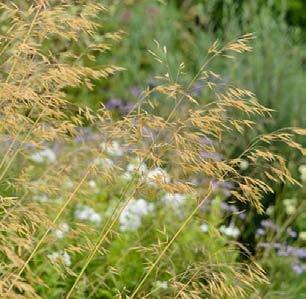

Summer lovin’
During the grip of lockdown many of us have spent longer in the garden then usual and hopefully this productivity has paid off, with weed-free borders, neat edges, and new planting schemes or raised beds. The early July rain will certainly have helped get things moving so as we head into summer there is still plenty to keep your green fingers busy.
The roses this July have been spectacular, providing a gorgeously fragrant display in your borders and leaving a blanket of confetti as they start to fade. To lengthen their season deadheading is a must, and you can also cut back suckers and any canes that are growing inwards to let the light in and air to circulate. Don’t forget to pick a blousy sprig or two for your kitchen so you can enjoy their heady scent.
Tales from the potting shed
July Cut back early perennials Deadhead roses Sow winter veg crops
As we ease into August, water your pots, mow the lawn weekly, cut back summerflowering shrubs such as lavender once they have finished flowering and take a few cuttings of your new favourites to look forward to next year. Enjoy the bounty that your veggie plot brings this month: lettuce, tomatoes, cucumber, runner beans, even the first autumn cauliflower, and cook up a summer feast for friends and family.
September rolls in with its misty mornings and gentle dappled afternoons. Colours start to mellow, and the stage cleared for dahlias, dramatic balls of vibrancy that are best planted together for impact. Beds and borders take on the rusty hues of chrysanthemum, spirits are lifted by the glorious deep orange of crocosmia, and drifts of ornamental grasses such as ‘Stipa gigantea’ glow in the autumn sun.






